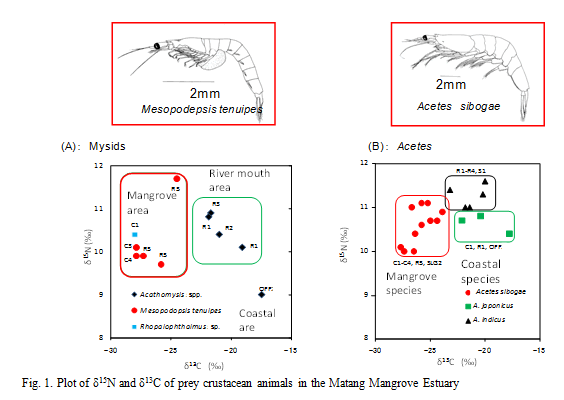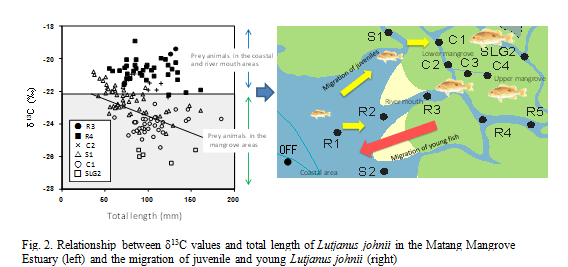The importance of large scale mangrove estuaries as feeding grounds for commercially important juvenile fishes
Description
Mangroves contribute substantially to coastal fisheries in terms of providing trophic and refuge support. Typically, the adults of many tropical fish species spawn in the offshore area, producing eggs that develop into planktonic larvae which move or are carried by currents into the inshore and mangroves. However, the mangrove areas surveyed in almost all studies are on the small scale mangroves of normally less than 1 km width, and there are few studies focusing on the large mangrove estuaries. The Matang Mangrove Forest Reserve (MMFR), situated on the northwestern coast of Peninsular Malaysia, is reputed to be the world’s best managed mangrove forest. The reserve is the largest single tract of mangrove forest in Peninsular Malaysia (40,151 ha), measuring 52 km between the extreme ends and 13 km wide in the middle, and has been managed as a sustainable production forest since 1905. In this study, stable carbon and nitrogen isotope ratios of juvenile John’s snapper Lutjanus johnii and Caroun croaker Johnius carouna collected from the estuaries of MMFR were measured to investigate 1) the ontogenetic migration of the juveniles into and within the large and complex mangrove estuaries, and 2) the fish’s dependence on the food sources provided in the mangrove nursery area.
Prey animals in MMFR showed distinctive δ13C signatures between habitats and can be divided into two groups: one group with generally enriched δ13C values closely associated with coastal and lower estuarine areas; the other group with more depleted δ13C values captured in the upper mangrove areas (Fig. 1). Corresponding with the isotope values of these prey animals, juveniles of John’s snappers and Caroun croaker also had more enriched δ13C values in the lower estuarine areas than in the upper mangrove areas. The remarkable differences observed in the isotope ratios between these sampling sites reflect the difference in food sources between the two habitat groups (Fig. 2, left).
Small individuals of John’s snappers caught from the lower mangrove station (S1) had higher δ13C values that reflect the relatively higher δ13C values of the prey animals collected in the coastal stations (Fig. 2, left). This suggests that the small fish had recently migrated into the lower mangrove from the coastal area. The δ13C signature of larger juvenile John’s snappers collected from the upper mangrove areas showed more depleted values with their growth (Fig. 2, left). These results indicate the ontogenetic migration of John’s snappers spreading into the upper mangrove areas as far as 13 km from the river mouth after entering from the coastal areas (Fig. 2, right). On the other hand, Caroun croaker is a permanent resident in mangrove estuary both as adults and juveniles. The δ13C signature of Caroun croaker collected from the lower estuary showed more enriched values with their growth, suggesting that the contribution of mangrove-associated prey animals is higher in the smaller juveniles.
These findings of the present study have important implications for the fishery management of juvenile fish in the mangrove estuary. This study shows the importance of conserving sufficiently large single areas of mangrove with their complex interconnected waterways (including estuary, river, rivulet and creek) as exemplified by the large MMFR, as habitat and feeding grounds for John’s snapper and Caroun croaker.
Figure, table
- Affiliation
-
Japan International Research Center for Agricultural Sciences Fisheries Division
- Classification
-
Administration B
- Research project
- Program name
- Term of research
-
FY 2011 (FY 2011-FY 2015)
- Responsible researcher
-
Tanaka Katsuhisa ( Fisheries Division )
KAKEN Researcher No.: 40371835Watanabe Satoshi ( Fisheries Division )
KAKEN Researcher No.: 40371877Hanamura Yukio ( National Research Institute of Fisheries Science )
KAKEN Researcher No.: 50371951Kodama Masashi ( National Research Institute of Fisheries Science )
Ichikawa Tadafumi ( National Research Institute of Fisheries Science )
KAKEN Researcher No.: 50371886Man Alias Bin ( Fisheries Research Institute, Malaysia )
Chong Ving-Ching ( University of Malaya )
- ほか
- Publication, etc.
-
Tanaka et al. (2011) Fisheries Science, 77:809-816
Tanaka et al. (2012) JIRCAS Working Report, 75 : 1-6
- Japanese PDF
-
2011_16_A4_ja.pdf259.54 KB
- English PDF
-
2011_16_A4_en.pdf351.16 KB


